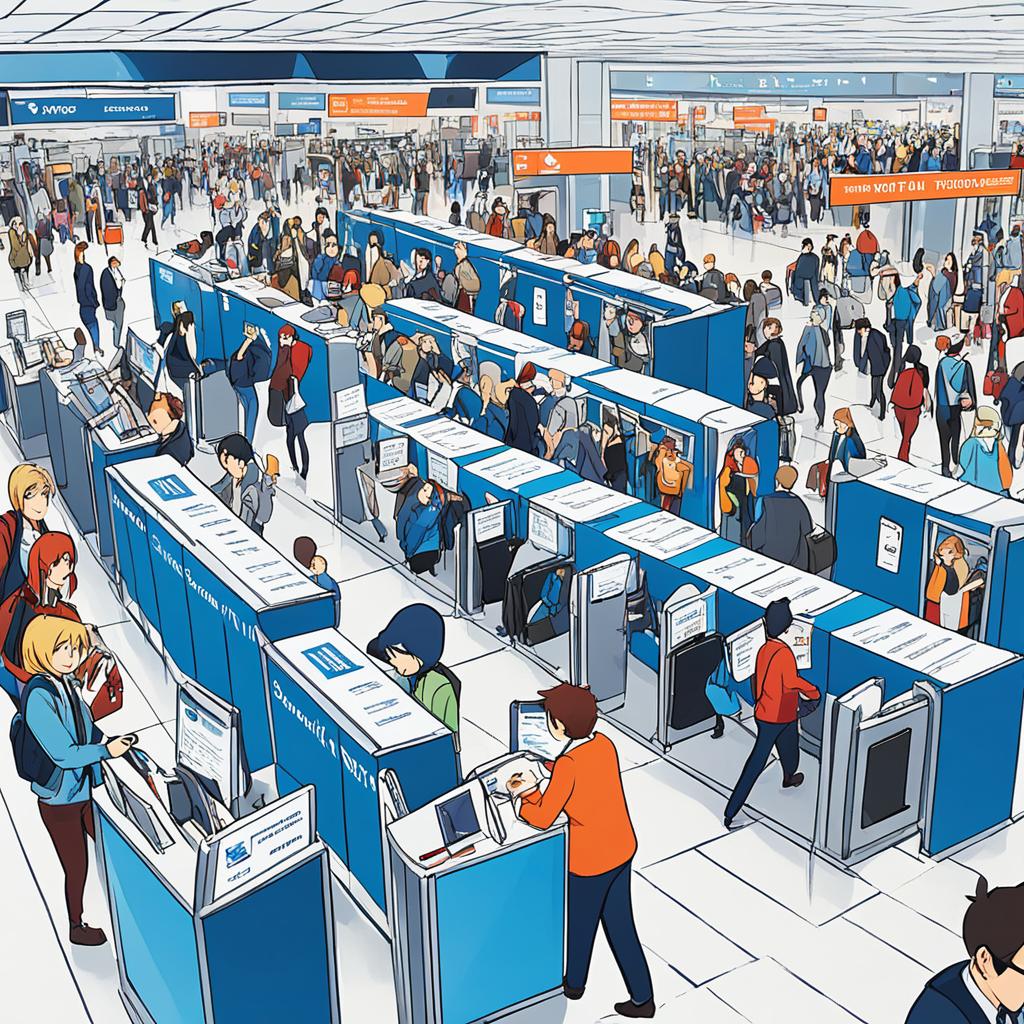When traveling internationally and connecting to a domestic flight at Los Angeles International Airport (LAX), many passengers wonder about the customs and immigration procedures. Do you have to go through the hassle of clearing customs when you are not leaving the airport? Let’s dive into the facts and find out what you need to know for a smooth transfer experience.
Traveling can be stressful, especially when you have a tight connection. Understanding the processes involved in transferring from an international flight to a domestic one can help you plan your journey effectively and avoid unexpected surprises. So, let’s uncover the truth about customs clearance at LAX and how it affects your connecting flight.
Arriving at LAX on an International Flight

Los Angeles International Airport (LAX) is a major hub for international travel, serving countless passengers every day. If you are arriving at LAX on an international flight, here is what you need to know about the disembarking process and transferring to your domestic flight.
LAX has nine terminals, each catering to different airlines. Upon arrival, you will need to follow the disembarking process, which includes completing immigration and customs procedures. It is essential to allow ample time for these procedures, as they can take some time to complete.
When disembarking, make sure to have all your travel documents readily available. This includes your passport, visa, and any other required documentation. You will need to present these to the immigration officers for inspection.
Customs officers will also inspect your luggage and may ask you questions about your trip. Be prepared to answer truthfully and declare any items you are bringing into the country.
Once you have cleared immigration and customs, you may need to recheck your luggage before proceeding to your domestic flight. Be sure to check with your airline if you need to recheck your bags or if they will be transferred for you.
| Terminal | Airlines |
|---|---|
| Terminal 1 | Southwest Airlines |
| Terminal 2 | Aer Lingus, Aeroméxico, WestJet |
| Terminal 3 | Delta Air Lines |
| Terminal 4 | American Airlines |
| Terminal 5 | Hawaiian Airlines, JetBlue Airways |
| Terminal 6 | Alaska Airlines, Copa Airlines |
| Terminal 7 | United Airlines |
| Terminal 8 | United Airlines |
| Terminal TBIT | International carriers |
It is important to familiarize yourself with the terminals at LAX to ensure a smooth transfer. You can refer to the table above to find the terminal associated with your airline.
Once you have completed the disembarking process and collected your belongings, follow the signs and directions to your domestic departure terminal. LAX offers various transportation options between terminals, including complimentary shuttle services, ride-sharing services like Uber or Lyft, as well as public transportation.
Remember to allow ample time for your connection and consider the walking times between terminals when planning your transfer. LAX can be busy, especially during peak travel hours, so plan accordingly to avoid any unnecessary stress.
Clearing Customs and Immigration at LAX

Passengers arriving at LAX on international flights are required to go through the customs and immigration process before entering the United States. This involves several important procedures that must be followed to ensure a smooth and efficient transition.
Customs Declaration Form
Upon arrival at LAX, you will need to present your passport and complete a customs declaration form. This form requires you to provide information about the items you are bringing into the country, including their value and quantity. It is important to be accurate and truthful on this form, as providing false information can result in substantial fines and penalties.
Immigration Checkpoint
After completing the customs declaration form, you will proceed to the immigration checkpoint. Here, you will present your passport and any necessary travel documents, such as your visa or ESTA approval. The immigration officer will review your documents and may ask you questions about your trip, including your purpose of visit and length of stay. It is important to answer these questions truthfully and cooperate with the officer.
Security and Baggage Inspection
Once you have cleared the immigration checkpoint, you will proceed to the security and baggage inspection area. Here, your carry-on and checked luggage will be screened for prohibited items. It is important to follow all instructions from the security personnel and remove any electronic devices and liquids from your carry-on luggage for separate screening.
Global Entry and CBP Trusted Traveler Programs
For low-risk travelers, programs such as Global Entry and CBP Trusted Traveler offer expedited clearance through customs and immigration. These programs require pre-approval and an enrollment process before you can take advantage of their benefits. While these programs can help facilitate the clearance process, it is important to note that they do not guarantee expedited security screening or access to dedicated immigration lanes.
Completing the customs and immigration procedures at LAX is an essential part of the arrival process for international passengers. It is important to have all necessary travel documents readily available and to follow all required procedures to ensure a smooth transition into the United States.
Transferring to Your Domestic Departure Terminal
To ensure a smooth transfer experience at Los Angeles International Airport (LAX), it is essential to familiarize yourself with the airport layout and the location of your domestic departure terminal. LAX consists of nine passenger terminals, and navigating between them can be made easier with the help of airport maps and signage.
When planning your transfer, it is crucial to consider the walking times between terminals. While LAX provides complimentary shuttle services that can transport you between terminals, walking may be a more efficient option depending on your specific circumstances.
Transportation Options at LAX
Aside from walking and shuttle services, LAX offers a range of transportation options to cater to your needs:
- Ride-sharing services: Companies like Uber and Lyft operate at LAX and provide convenient transportation between terminals. Simply book a ride through their respective mobile apps.
- Public transportation: LAX is well-connected to the greater Los Angeles area through various public transportation options, including buses and airport shuttles. These services can take you to nearby locations or connect you to other transportation hubs.
- Parking facilities: If you prefer to drive yourself, LAX offers parking facilities with both short-term and long-term options. Be sure to familiarize yourself with the parking rates and availability before your journey.
Regardless of your chosen mode of transportation, it is essential to allocate ample time for connections, as traffic and other factors may influence travel times. Taking into account potential walking distances or shuttle wait times between terminals, it is always wise to give yourself a buffer to ensure a stress-free transfer experience.
Image
The image above provides an overview of the airport layout at LAX, allowing you to visualize the arrangement of the various terminals.
Checking-In and Boarding Your Domestic Flight

Once you’ve arrived at LAX and completed the necessary customs and immigration procedures, it’s time to check-in and board your domestic flight. Here’s what you need to know:
1. Locate your airline’s terminal: LAX has nine terminals, each serving different airlines. To check-in and board your flight, you’ll need to find the terminal that corresponds to your airline. You can find this information on your airline’s website or ticket.
2. Online check-in: Save time and skip the check-in line by taking advantage of online check-in options offered by most airlines. Simply visit your airline’s website and follow the prompts to check-in online. Make sure to print your boarding pass or save it on your mobile device.
3. Baggage policies and security procedures: Familiarize yourself with your airline’s baggage policies to ensure you meet the requirements for size, weight, and number of bags. Additionally, be aware of the security procedures and restrictions in place for domestic flights. For more information, visit the Transportation Security Administration (TSA) website.
4. Boarding announcements: Keep an eye out for boarding announcements displayed on the departure screens throughout the terminal. Listen for announcements over the PA system or through the airline’s mobile app if available. Boarding typically begins around 30 minutes before the scheduled departure time.
5. Embrace a comfortable wait: While waiting to board, take advantage of the amenities available in the terminal. Grab a bite to eat, do some shopping, or simply relax before your flight.
| Airline | Terminal |
|---|---|
| American Airlines | Terminal 4 |
| Delta Air Lines | Terminal 2 and Terminal 3 |
| United Airlines | Terminal 7 and Terminal 8 |
| Southwest Airlines | Terminal 1 |
Note: The table above provides a sample of airlines and their corresponding terminals at LAX. Please check with your specific airline for accurate information regarding terminal assignments.
By following these steps, you’ll ensure a smooth check-in and boarding process for your domestic flight at LAX. Now that you’re prepared, it’s time to enjoy your journey to the next destination!
Tips for a Smooth Transfer Experience at LAX
When traveling through Los Angeles International Airport (LAX) and transferring between flights, it’s crucial to plan ahead to ensure a seamless experience. Here are some essential tips to help you make the most of your transfer at LAX:
- Allow ample time for connections: LAX is one of the busiest airports in the world, so it’s important to factor in enough time for your connection, especially if you’re arriving on an international flight. We recommend allowing at least two to three hours between an international arrival and a domestic departure to account for customs and immigration procedures.
- Make backup plans for tight connections: If you have a tight connection and are concerned about making it to your next flight on time, it’s wise to have a backup plan in place. Familiarize yourself with alternative flights or routes that you can take if needed. It’s also a good idea to communicate with the airline beforehand to let them know about your situation.
- Avoid the busiest times: LAX experiences peak traffic during midday and evening hours, leading to longer wait times and potential delays. Try to schedule your flights during off-peak times to minimize the likelihood of encountering congestion.
By following these tips, you can improve your chances of having a smooth transfer experience at LAX. Remember to allow sufficient time, plan for any contingencies, and avoid the busiest times to ensure a stress-free journey.
Additional Resources at LAX
When traveling through Los Angeles International Airport (LAX), take advantage of the additional resources available to enhance your transfer experience. LAX provides convenient airport shuttles that run frequently between terminals, ensuring seamless transportation within the airport. These shuttles are wheelchair accessible, catering to the needs of all passengers.
To stay informed about the shuttle schedules and routes, you can check for live shuttle updates. LAX offers a user-friendly shuttle map app that provides real-time information, allowing you to track the location of the shuttles and plan your transfer accordingly. By utilizing this app, you can streamline your journey and navigate the airport with ease.
As part of a smooth transfer process, it is crucial to keep security wait estimates in mind. By checking the security wait times at LAX, you can make more informed decisions and avoid potential delays. This information helps you allocate sufficient time for the security screening process, ensuring a stress-free transfer to your next destination.
FAQ
Q: Do you have to clear customs on a connecting flight at LAX?
A: Yes, passengers are required to clear customs and immigration at LAX when connecting from an international flight to a domestic flight, even if they are not leaving the airport.
Q: What is the disembarking process for passengers arriving at LAX on an international flight?
A: Passengers arriving on international flights at LAX will need to complete immigration and customs procedures. This includes presenting their passport, visa, and any other required documentation to immigration officers, as well as having their luggage inspected by customs officers. After clearing immigration and customs, passengers may need to recheck their luggage before proceeding to their domestic flight.
Q: What are the required procedures for clearing customs and immigration at LAX?
A: Passengers arriving at LAX on international flights are required to pass through customs and immigration. This includes presenting their passport, completing a customs declaration form, and going through the immigration checkpoint. Passengers may be asked to declare any items they are bringing into the country.
Q: How do I transfer to my domestic departure terminal at LAX?
A: It is important to familiarize yourself with the layout of LAX and the location of your domestic departure terminal. LAX has nine terminals, and there are airport maps and signage to help passengers navigate their way. Transportation options at LAX include complimentary shuttle services between terminals, ride-sharing services like Uber or Lyft, public transportation, and parking facilities.
Q: How do I check-in and board my domestic flight at LAX?
A: Passengers need to locate their airline’s terminal for the check-in and boarding process of their domestic flight. LAX has nine terminals, and passengers should check their airline’s website or ticket for the terminal number. Most airlines offer online check-in options, which can save time at the airport. Passengers should also be aware of the baggage policies and security procedures for their domestic flight.
Q: What tips do you have for a smooth transfer experience at LAX?
A: To have a smooth transfer experience at LAX, it is important to allow sufficient time for connections, especially for international arrivals. It is recommended to allow at least two to three hours between an international arrival and a domestic departure, taking into account customs and immigration procedures. Passengers should make backup plans for tight connections and communicate with the airlines if they are at risk of missing their transfer. The busiest times at LAX are during midday and evening hours, so passengers should plan accordingly.
Q: What additional resources are available at LAX to help with the transfer process?
A: LAX offers additional resources to help passengers navigate the airport and make their transfer experience easier. Airport shuttles run frequently between terminals and are wheelchair accessible. Passengers can check for live shuttle updates and download the LAX shuttle map app for real-time information. It is also important to check security wait estimates and plan accordingly to avoid any delays during the transfer process.
